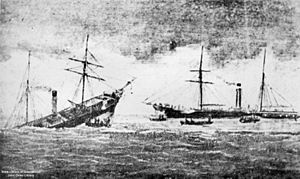SS City of Launceston facts for kids
The SS City of Launceston was a steamship that sailed in Australia a long time ago. It was operated by the Launceston and Melbourne Steam Navigation Company starting in 1863. This ship was very important for early travel between Tasmania and Victoria, much like the modern Bass Strait ferry service. Sadly, it sank in Port Phillip Bay on November 19, 1865, after hitting another ship.

Artist's impression of the City of Launceston sinking
|
|
Quick facts for kids History |
|
|---|---|
| Name | City of Launceston |
| Namesake | Launceston, Tasmania |
| Owner | Launceston & Melbourne Steamship Company |
| Port of registry | Launceston, Tasmania |
| Builder | Blackwood & Gordon, Paisley |
| Cost | £17,000 |
| Yard number | 55 |
| Launched | 4 April 1863 |
| In service | October 1863 |
| Identification | official number: 32240 |
| Fate | Sank after collision, 19 November 1865 |
| General characteristics | |
| Type | cargo and passenger ship |
| Tonnage |
|
| Length | 177 ft 2 in (54.00 m) |
| Beam | 24 ft 5 in (7.44 m) |
| Depth | 11 ft 8 in (3.56 m) |
| Propulsion | 2 cylinder 80 hp (60 kW) steam engine, Single screw |
| Sail plan | Schooner-rigged on two masts |
| Capacity | 188 passengers |
Contents
Building and Early Voyages
The City of Launceston was built in Paisley, Scotland. It was made of iron and cost about £17,000. The ship was launched on April 4, 1863. It was 177 ft (54 m) long and weighed 368 gross register tons (GRT).
The ship was designed to carry both people and goods. It used an 80 horsepower steam engine and also had sails on two masts.
Journey to Australia
The City of Launceston left Glasgow, Scotland, on June 6, 1863. It sailed all the way to Melbourne, Australia, arriving on September 16. While in Melbourne, the ship was changed from a brig to a schooner. This meant its sails were set up differently.
The company that owned the ship, the Launceston and Melbourne Steam Navigation Company, spent a lot of money to make it look great. It was their most important ship.
First Trial Trip
On October 21, 1863, the ship took a special trial trip. It sailed from Launceston to George Town. About 450 to 500 invited guests were on board. They enjoyed free drinks, food, and music from a brass band.
The ship left Launceston at 7:30 a.m. and reached George Town in less than three hours. Guests explored the town and beach. They had a big lunch before the ship sailed back at 3:30 p.m., arriving by 6:00 p.m. For the next two years, the ship safely carried passengers, mail, and cargo across the Bass Strait.
The Ship's Final Voyage
On November 19, 1865, the City of Launceston left Port Melbourne. It was 7:20 p.m., and Captain William Thompson was in charge. There were 23 crew members and 25 passengers on board. The ship was carrying many different items, including mail, luggage, clothes, and drinks. The evening was clear and calm.
Collision at Sea
The City of Launceston saw another ship, the SS Penola, coming towards it. The Penola was sailing from Adelaide. The two ships were about five miles apart. According to sea rules, ships coming head-on should turn to the left to pass safely.
However, this did not happen. The two ships kept getting closer. Around 9:00 p.m., the Penola crashed directly into the right side of the City of Launceston.
Rescue and Sinking
As the City of Launceston began to sink, everyone on board was moved to the Penola. Even though the Penolas front part was stuck in the Launcestons side, it was still able to reach port safely. The City of Launceston sank to the bottom of the bay.
Discovering the Wreck
About a week after the crash, divers went down to the sunken ship. They found and brought up 56 mailboxes, some bags, and other items. The next year, people tried to lift the ship using special canvas bags filled with hydrogen gas. This attempt was not successful.
A Protected Underwater Site
The City of Launceston wreck was found again in 1980. This was done by members of the Maritime Archaeology Association of Victoria. It became the first shipwreck to be officially protected under a law called the Historic Shipwrecks Act of 1981.
The wreck is still upright in 21 metres (69 ft) of water. Most of it is still in one piece. Since 1997, experts from Heritage Victoria have been studying the wreck.

